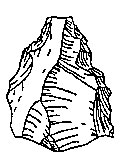(Artifact pictures are from Richard Klein's The Human Career, 2nd edition. Chicago: University of Chicago Press, 1999).
I was one of 30 members of the 64th (and 65th) College of Distinguished Lecturers of Sigma Xi, the Scientific Research Society.
My basic information is provided on the 2001/2002 Distinguished lecturers page at the Sigma Xi website, and was in the January/February 2001 issue of American Scientist.
Information about 2002/2003 Distinguished lecturers, which was also in the January/February 2002 issue of American Scientist.
For more information about the University of Alberta chapter of Sigma Xi (chapter 811), click here. I was President of this chapter for 2002/03.
 Basic
biographical information
Basic
biographical information
Pamela R. Willoughby is a Professor of Anthropology at the University of Alberta, and received her Ph.D. from UCLA. She has been a SSHRC (Social Sciences and Humanities Research Council) Canada Research Fellow at the University of Alberta, and from 1994 to 2008, she was the editor of Nyame Akuma: Bulletin of the Society of Africanist Archaeologists. Her main fields of interest are Palaeolithic archaeology, ancient technology, African prehistory as well as human biological and cultural evolution. She directs an archaeological field project investigating the origins and early evolution of our own species, Homo sapiens in the Iringa region of southern Tanzania.
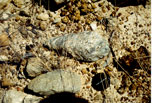 Handaxes
from the Acheulean site of Isimila, Tanzania.
Handaxes
from the Acheulean site of Isimila, Tanzania.
Three lecture titles (click link to see more information about each lecture).
1) Mitochondrial Eve and the Middle Stone Age: The African origin of modern humans (public, general or specialized audience).
(2) The people without culture?: the archaeology of early modern humans in Africa (public, general or specialized audience).
(3) The Great Rift Valley: East African evidence for our remote past (public or general audience).
 Visits
in 2001/02
Visits
in 2001/02
February 13, 2002: Roche Research, Nutley, New Jersey.
February 18-24, 2002: California State University at Northridge and Loyola Marymount University, Los Angeles, California.
March 16-19, 2002: Memorial University of Newfoundland, St. John's, Newfoundland.
March 26-28, 2002: Oklahoma State University, Stillwater, Oklahoma.
Visits in 2002/03
April 16-18, 2003: Texas Christian University, Fort Worth, Texas.
April 27-29, 2003: Mesa State College, Grand Junction, Colorado.
May 3-7, 2003: Gustavus Adolphus College, St. Peter, Minnesota.
More information about lecture content.
(1) Mitochondrial Eve and the Middle Stone Age: The African origin of modern humans (public, general or specialized audience).
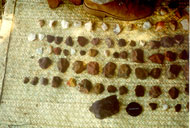 MSA
artifacts from Southwestern Tanzania
MSA
artifacts from Southwestern Tanzania
-ever since geneticists began collecting blood samples for population studies, we have known that there is little genetic variation in humans; "races" are more social concepts (reflecting ethnicity, language, culture) than true biological units
-there is more genetic variation within "races" than between them
-in 1987, Rebecca Cann, Mark Stoneking and Alan Wilson published a paper in Nature examining maternally inherited mitochondrial DNA variation in living humans; their results point to a common female ancestor ("mitochondrial Eve") who was African and whose population existed between 100,000 and 200,000 years ago
-this has since been confirmed by studies of the male (Y) chromosome, as well as in nuclear DNA; although Underhill et. al. (2000) feel that the last common male ancestor existed as recently as 50,000 years ago
-new geochronological methods developed in the 1980s confirmed that the first anatomically modern Homo sapiens in Africa date to the Middle Palaeolithic/Middle Stone Age, between 200,000 and 30,000 years ago
-this was surprising as MP/MSA artifacts were similar to those of the European neandertals, people who our direct ancestors replaced around 40,000 to 30,000 years ago
-what were the processes underlying the origins of modern Homo sapiens, and when and why did some of their descendants leave Africa to populate the world?
-this talk describes the problem of the origins of modern humans, and how genetic research has focused attention on a poorly known period of the African past; not only is Africa the continent which saw the origins of the first humans, it was the homeland for our own species
-it also discusses how my own field research on the MSA and LSA in southwestern Tanzania may help to understand this problem
(2) The people without culture?: the archaeology of early modern humans in Africa (public, general or specialized audience).
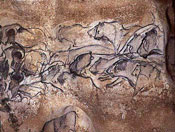 Chauvet
Cave lions, France.
Chauvet
Cave lions, France.
-current models of the origins of our own species suggest an African origin, between 100,000 and 200,000 years ago
-the first anatomically modern Homo sapiens fossils came from the Cro Magnon rockshelter in Les Eyzies, France, and were excavated in 1868
-in Europe, modern Homo sapiens are associated with Upper Palaeolithic stone tools; here both the hominid species and the archaeology changed around 30-40,000 years ago
-modern humans replaced the indigenous neandertal populations, and there appears to be a sharp break in biological populations as well as in technology and culture
-the Upper Palaeolithic sees a number of innovations: blade tools; ivory, bone and antler artifacts; figurines and cave paintings and/or engravings, complex burials, and other signs which are considered to represent true modernity in behaviour
-it was assumed that these innovations occurred because modern humans, with the same intellectual capacities as ourselves, first appear at this time
-but by the 1980s, genetic and fossil data, along with new methods for dating archaeological sites confirmed an African origin for modern humans, well before the Upper Palaeolithic started
-the earliest modern Homo sapiens fossils are associated with Middle Palaeolithic (in North Africa) and Middle Stone Age (MSA south of the Sahara) artifacts in Africa and date to before 100,000 yeas ago; the artifacts are similar to those made by the European neandertals
-African archaeologists are split between those who see MP/MSA Africans as completely modern in the Upper Palaeolithic sense, and those like Richard Klein of Stanford University who feel that some other behavioural or biological change (such as neural re-organization for true language and symbolic thought) had to occur before they were truly modern
-what does "modernity" mean biologically and culturally?
-this talk describe the traditional Upper Palaeolithic model, how new research unexpectedly points to Africa as the place of modern human origins, and how archaeologists, including the author, have had to change their perspectives on the role of Africa in later human evolution
-it also describes the growing body of evidence for complex Upper Palaeolithic-like technology present in the African MP/MSA; it is possible that African humans were modern in all respects quite early
-were there really people without culture prior to the Upper Palaeolithic? What would this infer about the earliest tool making human groups?
(3) The Great Rift Valley: East African evidence for our remote past (public or general audience).
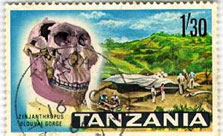 Zinjanthropus
and Olduvai Gorge, Tanzania
Zinjanthropus
and Olduvai Gorge, Tanzania
-this talk is more of a travelogue, and describes current research in East Africa on human origins and early evolution
-the title is taken from a book by the geologist J. W. Gregory, The Great Rift Valley (London: John Murray, 1896). It describes his trip through Kenya, and is a combination of geology, geography and ethnography of contemporary people.
-the geology of the East African Rift Valley system has led to the preservation of the some of the world's earliest human fossils and archaeological sites, and their subsequent exposure and discovery by researchers
-while we have known since the 1960s of the paramount role of Africa in the evolution of the first humans or hominids, we now know that all stages of human evolution took place on the continent
-while we used to think there were one or two kinds of humans at the same time, now palaeoanthropologists feel that there were many coeval hominid species, all of whom were bipedal; only one of them, our direct ancestors, survived and ultimately populated the world
-our perspectives on human evolution have changed a number of times in the last few decades
-in the late 1960s and 1970s, the first genetic studies were done on primates by geneticists such as Alan Wilson and Vincent Sarich of the University of California at Berkeley; these pointed out the strong similarity of African apes (chimpanzees and gorillas) to humans, implying that they shared a recent common ancestry
-these results contradicted the interpretation of the fossil record of human evolution, as it was understood at the time
-in 1982, with the discovery of more complete fossil remains of apes that palaeoanthropologists concluded that the geneticists were right: the last common ancestor of chimpanzees, gorillas and humans lived in Africa between 5 to 8 million years ago, a period for which no fossil evidence was available until recently
-the oldest known fossil hominids or early humans are around 4-6 million years old
-new early hominids are constantly being located and described, including Martin Pickford's Orrorin tugenensis, from Lake Baringo, Kenya, and Yohannes Haile-Selassie's Ardipithecus ramidus kadabba from the Middle Awash valley of Ethiopia, announced in the July 12, 2001 issue of Nature
-the earliest forms are bipedal apes, so bipedalism many not be something unique to humans
-in all periods, the diversity of fossil forms is increasing, leading to different models of the tempo and mode of evolution
-new genetic studies of African great apes also contribute to our understanding of human evolution
-evidence from East Africa may also help explain the origin of our own species, Homo sapiens, something which took place before 100,000 years ago
-this talk will discuss how our understanding of human evolution has changed in the last 30 years, as more fossil, genetic and archaeological information is acquired
References
Cann, R., M. Stoneking and A. C. Wilson (1987). Mitochondrial DNA and human evolution. Nature 325(6099): 31-36.
Underhill, P. et. al. (2000). Y chromosome sequence variation and the history of human populations. Nature Genetics 26(3): 358-361.
Click here to go back to Pam Willoughby's home page.
Return to top of page.
Return to Sigma Xi home page.
